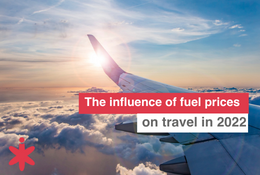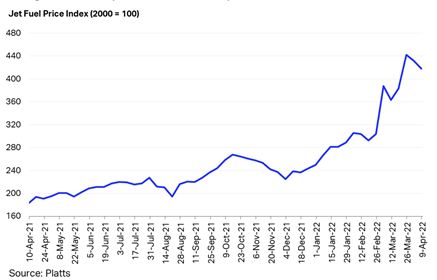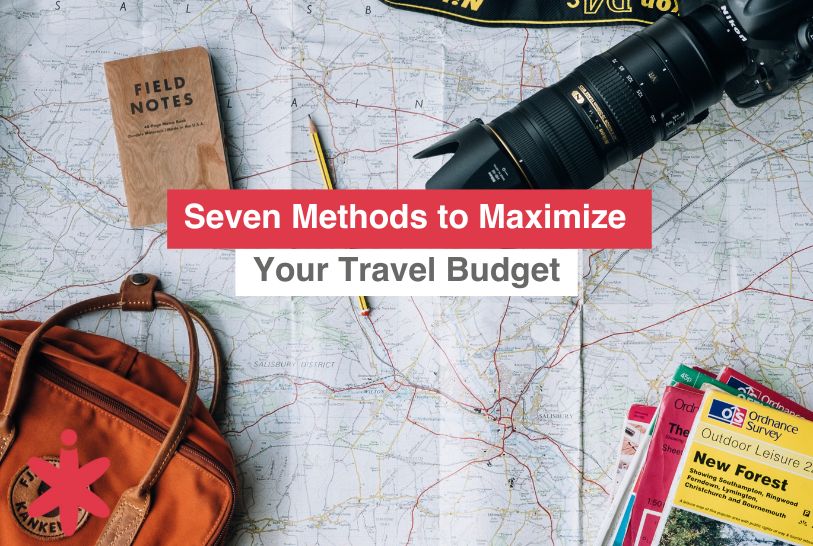The influence of fuel prices on travel in 2022
The influence of fuel prices on travel in 2022

Solidarity tourism, a more responsible way of traveling
19/04/2022
Evolution of MICE tourism in Spain
10/05/2022The influence of fuel prices on travel in 2022

In the lead up to the 2022 European summer, after two years of pandemic restrictions, it was expected that tourism and travel statistics would be reaching similar numbers to those of 2019. However, recent global events, such as the invasion of Ukraine, have affected the travel plans of European tourists .
According to IATA, the average fuel price in the aviation sector this year so far is USD$152.87 per barrel, which is an increase of 128.5% from the previous year.
Key contributors to the increase of jet fuel prices in the sector
There are two main reasons as to why the price of jet fuel is increasing in 2022, the first is the recent invasion of Ukraine. Self imposed Sanctions and the boycotting of Russian oil has meant Europe no longer has its main diesel supplier. Furthermore, the avoidance of Russian airspace means that airlines must choose new and potentially longer travel routes.
According to data published by ForwardKeys, a specialist travel intelligence consultancy company that provides information not only on the flow of international travellers, but also on their behaviour and preferences, we can see how cancellations of trips to and from Russia spiked on the day of the invasion of Ukraine. Prior to the cancellation of flights, the Russian tourist economy was 25% ahead of pre pandemic levels. Suddenly, however, new bookings dropped by 77%. Germany exhibited the highest cancellation rate of 773%, followed by France (472%) and the United Kingdom (254%).
Destinations such as Turkey, Greece, Germany and the Maldives were also affected by cancellations from Russian tourists. However, undoubtedly, the eastern countries closest to the conflict suffered the greatest consequences with more than a 50% decrease in flight bookings globally.
On the other hand, although the invasion has caused a stall in flights, flight bookings from the United States have only reduced by 13% compared to the 23% cancellation of Intra European flights. This suggests that American tourists are still interested in travelling to Europe.
Secondly, there is the developing global diesel shortage. Oil refineries reduced their extraction rates due to the lack of demand throughout the pandemic, some relying on inventories to reduce labour costs. Moreover, the post Covid-19 travel boom is outpacing the production and extraction of oil, therefore resulting in a higher demand for fuel within the aviation sector.
From this, airlines are debating how to compensate for the rising fuel prices. With a higher demand for travel as pandemic restrictions ease, it is highly likely that ticket prices will change, with some airlines already warning of a $15-20 increase.

(Source IATA – Increase in Jet fuel in the last 12 months)
How will this affect travel planning in the Spanish Market?
To understand how the increase of jet fuel prices in this sector could affect future travel plans, we can use data from Travellyze, the ITG Group Business Intelligence platform, with which we will be able to look at data collected on Spanish tourists who hold an extreme importance of direct flights when travelling abroad.
For example, if we look at the profile of Spanish travellers who are interested in travelling to the United States within the next three years, 26.3% are between the ages of 45 – 54 years, followed by travellers between 25-34 years (19.1%). These age groups have the average household income is 18.000- 35.999 euros (50%).
However, if we look at data regarding their expected travel budgets, 44.6% of travellers are only planning to spend €1,000 – €2,999 euro on their travel. Depending on which state and city tourists are planning to go to, flights from Madrid to the United States range from €355 to €1000 euros, coming close to the average budget. Moreover, 33.8% of travellers plan to keep their budget lower than the previous year, whilst 43.2% are aiming to keep it at the same amount. An increase in airline ticket prices could affect the sales and spending forecast of this demographic group, of whom is the most interested in travelling to the destination, and therefore affect the rest of the tourism chain.
Flights and accommodation go hand in hand when it comes to organising a trip, and with increasing flight prices, tourists may have to make compromises when it comes to accommodation in order to fit their budget. 3 and 4 star hotels are the most popular accommodation type, with budget hotels and hostels in second. Private rentals such as Airbnbs are in third. Furthermore, if prices continue to increase, tourists could opt for cheaper transport options such as trains or rental cars and travel to closer destinations. According to Travellyze 35.1% of Spanish tourists have chosen a train or bus as modes of transport over a plane.

The pandemic has influenced all stakeholders within the tourism industry, forcing them to revise their operating processes and purchasing decisions. Travellers who value direct flights also have a high level of importance in cleanliness (47.9%), health and hygiene standards (46.8%) and easy access to health and medical facilities. Additionally, the types of holidays tourists take will also be influenced by rising fuel prices.
For example, 75.7% of Spanish tourists interested in travelling to the United States, are also interested in a multi-destination tour, like visiting multiple destinations in one trip. With an increase in ticket prices, this travel behaviour may not be economically achievable for all tourists.
Are tourists willing to pay more for their ticket price?
Post pandemic travel is in high demand after years of restricted travel regulations, and research points out that European travellers are willing to spend more money on travel in 2022. However, a major increase in prices was not previously predicted. Airlines, like all other tourism operators, need to stay on track with their recovery plans and if consumer purchasing decisions change, this could have a flow-on of consequences for destinations in general.
An example;
- If tourists purchase more expensive flights, they may have to look into alternative and cheaper types of accommodation, like a budget hostel instead of a 3 or 4 star hotel.
- If the visitor nights at the hotel start to drop, the hotel will have to raise its prices, in which it could deter possible clients.
- If the tourists spend most of their budget on flights and accommodation, their choice of activities once they are at the destination may be limited.

Taking into account the previously mentioned data, and as the conclusion of the article, we could argue that the increased fuel prices may influence purchasing and travel planning trends in the post Covid-19 era. However, I believe that the demand for travel that has been produced throughout the pandemic will be a major factor that, even though prices may increase slightly, will not affect the number of trips taken now that the safety restrictions and measures are relaxing on a global level.
If we also take into account that according to our CEO Christopher Pomeroy, in his analysis of the behaviour of European tourists in 2022, 3% more of Spanish travellers are willing to spend between €3,000 and €5,000 per trip and book them more in advance, which could offer a more competitive rate.
From Interface Tourism Spain, we will continue to analyse the evolution of this topic, which is of vital importance when it comes to forecasting and changes in travel trends.
Gabby Hayton
Marketing Team


 All the news
All the news  Back to newsroom
Back to newsroom

